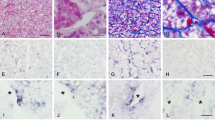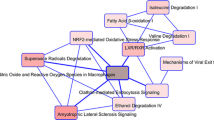Abstract
Object We analyzed MMP-9 expression using mRNA and protein level determinations and explored the possibility that Matrix metalloproteinase-9 (MMP-9) is a potential biological marker of pituitary adenoma invasiveness and whether MMP-9 could be used to discriminate the extent of invasiveness among different hormonal subtypes, tumor sizes, growth characteristics, and primary versus recurrent tumors. Materials and methods 73 pituitary tumor specimens were snap frozen in liquid nitrogen immediately after surgical resection. RNA and protein were extracted. MMP-9 mRNA transcripts were analyzed by quantitative RT-PCR. MMP-9 protein activity was analyzed by gelatin zymography and validated by western blot analysis. Immunohistochemistry was performed to identify the presence and localization of MMP-9 in pituitary adenomas. Statistical differences between results were determined using Student’s t-test or one way ANOVA. Results Comparing different hormonal subtypes of noninvasive and invasive pituitary tumors, MMP-9 mRNA expression was significantly increased in the majority of invasive adenomas. Considering the protein levels, our data also showed a significant increase in MMP-9 activity in the majority of invasive adenomas and these differences were confirmed by western blot analysis and immunohistochemistry. In addition, consistent differences in MMP-9 expression levels were found according to tumor subtype, tumor size, tumor extension and primary versus redo-surgery. Conclusions MMP-9 expression can consistently distinguish invasive pituitary tumors from noninvasive pituitary tumors and would reflect the extent of invasiveness in pituitary tumors according to tumor subtype, size, tumor extension, primary and redo surgery, even at early stages of invasiveness. MMP-9 may be considered a potential biomarker to determine and predict the invasive nature of pituitary tumors.






Similar content being viewed by others
References
Selman WR, Laws ER, Scheithauer BW, Carpenter SM (1986) The occurrence of dural invasion in pituitary adenomas. J Neurosurg 64:402–407
Meiji BP, Lopes MS, Ellegala DB, Alden T, Laws ER (2002) The long-term significance of microscopic dural invasion in 354 patients with pituitary adenomas treated with transsphenoidal surgery. J Neurosurg 96:195–208
Knosp E, Steiner E, Kitz K, Matula C (1993) Pituitary adenomas with invasion of the cavernous sinus space: a magnetic resonance imaging classification compared with surgical findings. Neurosurgery 33(4):610–618 (Laws ER comment)
Isono M, Inoue R, Kamida T, Kobayashi H, Matsuyama J (2003) Significance of leptin expression in invasive potential of pituitary adenomas. Clin Neurol Neurosurg 105:111–116
Trouillas J, Daniel L, Guigard MP, Tong S, Gouvernet J, Jouanneau E, Jan M, Perrin G, Fischer G, Tabarin A, Rougon G, Figarella-Branger D (2003) Polysialylated neural cell adhesion molecules expressed in human pituitary tumors and related to extrasellar invasion. J Neurosurg 98:1084–1093
Kong YG, Su CB, Ren ZY, Wang RZ, Li GL, Dou WC, Zhang B, Tian SQ (2003) Measurement of soluble CD44v6 in peripheral blood as assistant diagnosis of invasive pituitary adenomas. [Article in Chinese]. Zhongguo Yi Xue Ke Xue Yuan Xue Bao 25:698–701
Thapar K, Scheithauer BW, Kovacs K, Pernicone PJ, Laws ER (1996) p53 expression in pituitary adenomas and carcinomas: correlation with invasiveness and tumor growth fractions. Neurosurgery 38(4):765–771
Takino H, Herman V, Weiss M, Melmed S (1995) Purine-binding factor (nm23) gene expression in pituitary tumors: marker of adenoma invasiveness. J Clin Endocrinol Metab 80:1733–1738
Amar AP, DeArmond SJ, Spencer DR, Coopersmith PF, Ramos DM, Rosenblum ML (1994) Development of an in vitro extracellular matrix assay for studies of brain tumor invasion. J Neuro-onc 20:1–15
Egeblad M, Werb Z (2002) New functions for the matrix metalloproteinases in cancer progression. Nature Rev 2:163–176
Werner JA, Rathcke IO, Mandic R et al (2002) The role of matrix metalloproteinases in squamous cell carcinomas of the head and neck. Clin Exp Metastasis 19:275–282
Horikawa T, Yoshizaki T, Sheen TS et al (2000) Association of latent membrane protein 1 and matrix metalloproteinase 9 with metastasis in nasopharyngeal carcinoma. Cancer 89:715–723
Ballin M, Comez SE, Sinha CC, Thorgeirsson UP (1988) Ras oncogene mediated induction of a 92 kDa metalloproteinase; strong correlation with the malignant phenotype. Biochem Biophys Res Commun 154:823–838
Bernhard ED, Gruber SB, Muschel RJ (1994) Direct evidence linking expression of matrix metalloproteinase 9 (92-kDa gelatinase/collagenase) to the metastatic phenotype in transformed rat embryo cells. Proc Natl Acad Sci USA 91:4293–4297
Hua J, Muschel R (1996) Inhibition of matrix metalloproteinase 9 expression by a ribozyme blocks metastasis in a rat sarcoma model system. Cancer Res 56:5279–5284
Nakajima M, Welch D, Wynn D, Tsuruo Y, Nocolson G (1993) Serum and plasma M(r) 92,000 progelatinase levels correlate with spontaneous metastasis of rat 13762NF mammary adenocarcinoma. Cancer Res 53:5802–5807
Watanabe H, Nakanishi I, Yamashita K, Hayakawa T, Okada Y (1993) Matrix metalloproteinase-9 (92 kDa gelatinase/type IV collagenase) from U937 monoblastoid cells: correlation with cellular invasion. J Cell Sci 104:991–999
Zucker S, Lysik RM, Zarrabi MH, Moll U (1993) M(r) 92,000 type IV collagenase is increased in plasma of patients with colon cancer and breast cancer. CancerRes 53:140–146
Sang QXA (1998) Complex role of matrix metalloproteinases in angiogenesis. Cell Res 8:171–177
Kawamoto H, Uozumi T, Arita K, Yano T, Hirohata T (1996) Type IV collagenase activity and cavernous sinus invasion in human pituitary adenomas. Acta Neurochir (Wien) 138:390–395
Laquerriere A, Yun J, Hemet JTJ, Tadie M (1993) Experimental evaluation of bilayered human collagen as a dural substitute. J Neurosurg 78:487–491
Zhao YG, Cao XM, Xiao AZ, Zhu C (1999) Expression of MMP-2, -9,TIMP-1, -2, -3 mRNA in rat uterus during estrous cycle. Dev Reprod Biol 8:1–10
Zhao YG, Xiao AZ, Newcomer RG, Park HI, Kang T, Chung LW, Swanson MG, Zhau HE, Kurhanewicz J, Sang QX (2003) Activation of pro-gelatinase B by endometase/matrilysin-2 promotes invasion of human prostate cancer cells. J Biol Chem 278:15056–15064
Lillehei KO, Kirschman DL, Kleinschmidt-DeMasters BK, Ridgway EC (1998) Reassessment of the role of radiation therapy in the treatment of endocrine-inactive pituitary macroadenomas. Neurosurgery 43:432–439
Hansen LK, Molitch ME (1998) Postoperative radiotherapy for clinically nonfunctioning pituitary adenomas. Endocrinologist 8:71–78
Hussaini IM, Trotter C, Zhao Y, Abdel-Fattah R, Amos S, Xiao A, Agi CU, Redpath GT, Fang Z, Leung GKK, Lopes MBS, Laws ER (2007) Matrix metalloproteinase-9 is differentially expressed in nonfunctioning invasive and noninvasive pituitary adenomas and increases invasion in human pituitary adenoma cell line. Am J Pathol 170(1):356–365
Yokoyama S, Hirano H, Moroki K, Goto M, Imamura S, Kuratsu J (2001) Are nonfunctioning pituitary adenomas extending into the cavernous sinus aggressive and/or invasive? Neurosurgery 49(4):857–863 (Laws ER Comment)
Scheithauer BW, Kovacs KT, Laws ER Jr et al (1986) Pathology of invasive pituitary tumors with special reference to functional classification. J Neurosurg 65:733–744
Turner HE, Nagy Z, Esiri MM, Harris AL, Wass JAH (2000) Role of matrix metalloproteinase 9 in pituitary tumor. Behav J Clin Endocrinol Metab 85(8):2931–2935
Pan LX, Chen ZP, Liu YS, Zhao JH (2005) Magnetic resonance imaging and biological markers in pituitary adenomas with invasion of the cavernous sinus space. J Neuro-Oncol 74:71–76
Pereda MP, Ledda MF, Goldberg V, Chervi’n A, Carrizo G, Molina H, Muller A, Renner U, Podhajcer O, Gunter EA, Stalla UK (2000) High levels of matrix metalloproteinases regulate proliferation and hormone secretion in pituitary cells. J Clin Endocrinol Metab 85:263–269
Kawamoto H, Kawamoto K, Mizoue T, Uozumi T, Arita K, Kurisu K (1996) Matrix metalloproteinase-9 secretion by human pituitary adenomas detected by cell immunoblot analysis. Acta Neurochir (Wien) 138(12):1442–1448
Beaulieu E, Kachra Z, Mousseau N, Delbecchi L, Hardy J, Béliveau R (1999) Matrix metalloproteinases and their inhibitors in human pituitary tumors. Neurosurgery 45(6):1432–1441
Li Z, Ren Y, Wu Q, Lin S, Liang Y, Liang H (2004) Macrophage migration inhibitory factor enhances neoplastic cell invasion by inducing the expression of matrix metalloproteinase 9 and interleukin-8 in nasopharyngeal carcinoma cell lines. Chin Med J 117(1):107–114
Marbaix E, Donnez J, Courtoy PJ, Eeckhout Y (1992) Progesterone regulates the activity of collagenase and related gelatinases A and B in human endometrial explants. Proc Natl Acad Sci USA 89:11789–11793
Scheithauer BW (1982) Surgical pathology of the pituitary and sellar region. In: Laws ER Jr, Randall RV, Kern EB et al (eds) Management of pituitary adenomas and related lesions with emphasis on transsphenoidal microsurgery. Appleton-Century-Crofts, New York, pp 129–218
Sautner D, Saeger W (1991) Invasiveness of pituitary adenomas. Pathol Res Pract 187:632–636
Kovacs K, Horvath E (1986) Adenomas with ACTH production. In Tumors of the pituitary gland. Armed Forces Institute of Pathology, Washington, pp 134–164
Bradley KJ, Wass JAH, Turner HE (2003) Non-functioning pituitary adenomas with positive immunoreactivity for ACTH behave more aggressively than ACTH immunonegative tumours but do not recur more frequently. Clin Endocrinol 58:59–64
Scheithauer BW, Jaap AJ, Horvath E, Kovacs K, Lloyd RV, Meyer FB, Laws ER, Young WF (2000) Clinically silent corticotroph tumors of the pituitary gland. Neurosurgery 47:723–730
Knappe UJ, Hagel C, Lisboa BW, Wilczak W, Ludecke DK, Saeger W (2003) Expression of serine proteases and metalloproteinases in human pituitary adenomas and anterior pituitary lobe tissue. Acta Neuropathol 106:471–478
Knappe UJ, Ludecke DK (1996) Persistent and recurrent hypercortisolism after transsphenoidal surgery for Cushing’s disease. Acta Neurochir (Wien) 65(Suppl):31–34
Liu W, Matsumoto Y, Okada M, Miyake K, Kunishio K, Kawai N, Tamiya T, Nagao S (2005) Matrix metalloproteinase 2 and 9 expression correlated with cavernous sinus invasion of pituitary adenomas. J Med Invest 52:151–158
Fahlbusch R, Buchfelder M (1988) Transsphenoidal surgery of parasellar pituitary adenoms. Acta Neurochir (Wien) 92:93–99
Scotti G, Yu CY, Dillon WP, Norman D, Colombo N, Newton TH, De Groot J, Wilson CB (1988) MR imaging of cavernous sinus involvement by pituitary adenomas. AJNR 9:657–664
Comtois R, Beauregard H, Somma M, Serri O, Aris JN, Hardy J (1991) The clinical and endocrine outcome to transsphenoidal microsurgery of nonsecreting pituitary adenomas. Cancer 68:860–866
Lozonschi L, Sunamura M, Kobari M, Egawa S, Ding L, Matsuno S (1999) Controlling tumour angiogenesis and metastasis of C26 murine colon adenocarcinomaby a new matrix metalloproteinase inhibitor, KB-R7785, in two tumour models. Cancer Res 59:1252–1258
Acknowledgments
We are grateful to Dr. Yunde Bao (Department of Microbiology, University of Virginia Health System) for excellent technical support.
Author information
Authors and Affiliations
Corresponding author
Rights and permissions
About this article
Cite this article
Gong, J., Zhao, Y., Abdel-Fattah, R. et al. Matrix metalloproteinase-9, a potential biological marker in invasive pituitary adenomas. Pituitary 11, 37–48 (2008). https://doi.org/10.1007/s11102-007-0066-2
Published:
Issue Date:
DOI: https://doi.org/10.1007/s11102-007-0066-2




